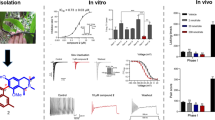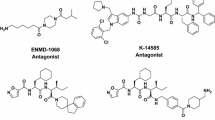Abstract
P2X receptors are hetero-oligomeric proteins that function as membrane ion channels and are gated by extracellular ATP. The hP2X\(_{3}\) subunit is a constituent of the channels on a subset of sensory neurons involved in pain signaling, where ATP released by damaged and inflamed tissue can initiate action potentials. Hence, the inhibition of ATP-activated P2X\(_{3}\) receptor is an exciting approach for the treatment of inflammatory and neuropathic pain. Recently, the crystal structures of zebrafish P2X\(_{4}\) (zP2X\(_{4})\) were obtained in closed, apo state (PDB ID: 3I5D) and ATP-bound, open state (PDB ID: 4DW1). These structures were used to develop a homology model of human P2X\(_{3}\) (hP2X\(_{3})\) in order to identify through docking studies, the binding modes of known P2X\(_{3}\) inhibitors and their key active site interactions, along with a pharmacophore-based 3D-QSAR model for a series of 136 Pyrid-2-yl and 2-CyanoPhenyl fused heterocyclic compounds. These 3D-QSAR models have been developed with different combinations of training and test set divisions obtained by random separation, Jarvis–Patrick clustering, K-means clustering and sphere exclusion methods. The best predictive 3D-QSAR model resulted in training set R \(^{2 }\)of 0.75, internal test set Q \(^{2}\) of 0.74, Pearson-R value of 0.87 and root mean square error of 0.37. The information generated by the pharmacophore model and docking analyses using the homology model provides valuable clues to design novel potent hP2X\(_{3}\) inhibitors.





Similar content being viewed by others
References
Sim JA, Chaumont S, Jo J, Ulmann L, Young MT, Cho K, Buell G, North RA, Rassendren F (2006) Altered hippocampal synaptic potentiation in P2X4 knock-out mice. J Neurosci 26:9006–9009. doi:10.1523/JNEUROSCI.2370-06.2006
Finger TE, Danilova V, Barrows J, Bartel DL, Vigers AJ, Stone L, Hellekant G, Kinnamon SC (2005) ATP signaling is crucial for communication from taste buds to gustatory nerves. Science 310:1495–1499. doi:10.1126/science.1118435
Mulryan K, Gitterman DP, Lewis CJ, Vial C, Leckie BJ, Cobb AL, Brown JE, Conley EC, Buell G, Pritchard CA, Evans RJ (2000) Reduced vas deferens contraction and male infertility in mice lacking P2X1 receptors. Nature 403:86–89. doi:10.1038/47495
North RA (2002) Molecular physiology of P2X receptors. Physiol Rev 82:1013–1067
Barrera NP, Ormond SJ, Henderson RM, Murrell-Lagnado RD, Edwardson JM (2005) Atomic force microscopy imaging demonstrates that P2X2 receptors are trimers but that P2X6 receptor subunits do not oligomerize. J Biol Chem 280:10759–10765. doi:10.1074/jbc.M412265200
Nakatsuka T, Gu JG (2006) P2X purinoceptors and sensory transmission. Pflugers Arch 452:598–607. doi:10.1152/physrev.0 0015.2002
Staikopoulos V, Sessle BJ, Furness JB, Jennings EA (2007) Localization of P2X2 and P2X3 receptors in rat trigeminal ganglion neurons. Neuroscience 144:208–216. doi:10.1016/j.neuroscience.2006.09.035
Khakh BS, Burnstock G, Kennedy C, King BF, North RA, Seguela P, Voigt M, Humphrey PP (2001) International union of pharmacology. XXIV. Current status of the nomenclature and properties of P2X receptors and their subunits. Pharmacol Rev 53:107–118
Virginio C, Robertson G, Surprenant A, North RA (1998) Trinitrophenyl-substituted nucleotides are potent antagonists selective for P2X1, P2X3, and heteromeric P2X2/3 receptors. Mol Pharmacol 53:969–973. doi:10.1124/mol.54.6.979
Jung KY, Moon HD, Lee GE, Lim HH, Park CS, Kim YC (2007) Structure–activity relationship studies of spinorphin as a potent and selective human P2X(3) receptor antagonist. J Med Chem 50: 4543–4547. doi:10.1021/jm070114m
Hausmann R, Rettinger J, Gerevich Z, Meis S, Kassack MU, Illes P, Lambrecht G, Schmalzing G (2006) The suramin analog 4,4\(^\prime \),4\(^{\prime \prime }\),4\(^{\prime \prime \prime }\)-(carbonylbis(imino-5,1,3-benzenetriylbis (carbonylimino)))tetra-kis-benzenesulfonic acid (NF110) potently blocks P2X3 receptors: subtype selectivity is determined by location of sulfonic acid groups. Mol Pharmacol 69:2058–2067. doi:10.1124/mol.106.022665
Grishin EV, Savchenko GA, Vassilevski AA, Korolkova YV, Boychuk YA, Viatchenko-Karpinski VY, Nadezhdin KD, Arseniev AS, Pluzhnikov KA, Kulyk VB, Voitenko NV, Krishtal OO (2010) Novel peptide from spider venom inhibits P2X3 receptors and inflammatory pain. Ann Neurol 67:680–683. doi:10.1002/ana.21949
Jarvis MF, Burgard EC, McGaraughty S, Honore P, Lynch K, Brennan TJ, Subieta A, Van Biesen T, Cartmell J, Bianchi B, Niforatos W, Kage K, Yu H, Mikusa J, Wismer CT, Zhu CZ, Chu K,linebreak Lee CH, Stewart AO, Polakowski J, Cox BF, Kowaluk E, Williams M, Sullivan J, Faltynek C (2002) A-317491, a novel potent and selective non-nucleotide antagonist of P2X3 and P2X2/3 receptors, reduces chronic inflammatory and neuropathic pain in the rat. Proc Natl Acad Sci USA 99:17179–17184. doi:10.1073/pnas.252537299
Jahangir A, Alam M, Carter DS, Dillon MP, Bois DJ, Ford AP, Gever JR, Lin C, Wagner PJ, Zhai Y, Zira J (2009) Identification and SAR of novel diaminopyrimidines. Part 2: the discovery of RO-51, a potent and selective, dual P2X(3)/P2X(2/3) antagonist for the treatment of pain. Bioorg Med Chem Lett 19:1632–1635. doi:10.1016/j.bmcl.2009.01.097
Gever JR, Soto R, Henningsen RA, Martin RS, Hackos DH, Panicker S, Rubas W, Oglesby IB, Dillon MP, Milla ME, Burnstock G, Ford AP (2010) AF-353, a novel, potent and orally bioavailable P2X3/P2X2/3 receptor antagonist. Br J Pharmacol 160:1387–1398. doi:10.1111/j.1476-5381.2010.00796.x
Cantin LD, Bayrakdarian M, Buon C, Grazzini E, Hu YJ, Labrecque J, Leung C, Luo X, Martino G, Pare M, Payza K, Popovic N, Projean D, Santhakumar V, Walpole C, Yu XH, Tomaszewski MJ (2012) Discovery of P2X3 selective antagonists for the treatment of chronic pain. Bioorg Med Chem Lett 22: 2565–2571. doi:10.1016/j.bmcl.2012.01.124
Brotherton-Pleiss CE, Dillon MP, Ford AP, Gever JR, Carter DS, Gleason SK, Lin CJ, Moore AG, Thompson AW, Villa M, Zhai Y (2010) Discovery and optimization of RO-85, a novel drug-like, potent, and selective P2X3 receptor antagonist. Bioorg Med Chem Lett 20:1031–1036. doi:10.1016/j.bmcl.2009.12.044
Wei ZL, Duncton MAJ, Kincaid J, Kelly MG, O’mahony D, Wang Z (2008) 2-CyanoPhenyl fused heterocyclic compounds and compositions and uses thereof. WO/2008/130481
Wei ZL, Kincaid J, Kelly MG, O’mahony D, Kaub C (2008) Pyrid-2-yl fused heterocyclic compounds and compositions and uses thereof. WO/2008/123963
Maestro (2011) Version 9.2, Schrödinger. LLC, New York
Kawate T, Michel JC, Birdsong WT, Gouaux E (2009) Crystal structure of the ATP-gated P2X(4) ion channel in the closed state. Nature 460:592–598. doi:10.1038/nature08198
Hattori M, Gouaux E (2012) Molecular mechanism of ATP binding and ion channel activation in P2X receptors. Nature 485:207–212. doi:10.1038/nature11010
Bodnar M, Wang H, Riedel T, Hintze S, Kato E, Fallah G, Groger-Arndt H, Giniatullin R, Grohmann M, Hausmann R, Schmalzing G, Illes P, Rubini P (2011) Amino acid residues constituting the agonist binding site of the human P2X3 receptor. J Biol Chem 286:2739–2749. doi:10.1074/jbc.M110.167437
Jiang LH, Rassendren F, Surprenant A, North RA (2000) Identification of amino acid residues contributing to the ATP-binding site of a purinergic P2X receptor. J Biol Chem 275:34190–34196. doi:10.1074/jbc.M005481200
Needleman SB, Wunsch CD (1970) A general method applicable to the search for similarities in the amino acid sequence of two proteins. J Mol Biol 48:443–453. doi:10.1016/0022-2836(70)90057-4
Thompson JD, Higgins DG, Gibson TJ (1994) CLUSTAL W: improving the sensitivity of progressive multiple sequence alignment through sequence weighting, position-specific gap penalties and weight matrix choice. Nucleic Acids Res 22:4673–4680. doi:10.1093/nar/22.22.4673
Maestro (2011) Version 9.2 LigPrep, Version 2.5 Schrodinger, LLC.: Portland
Dixon SL, Smondyrev AM, Knoll EH, Rao SN, Shaw DE, Friesner RA (2006) PHASE: a new engine for pharmacophore perception, 3D QSAR model development, and 3D database screening: 1. Methodology and preliminary results. J Comput Aided Mol Des 20:647–671. doi:10.1007/s10822-006-9087-6
Guvench O, Weiser J, Shenkin P, Kolossvary I, Still WC (2002) Application of the frozen atom approximation to the GB/SA continuum model for solvation free energy. J Comput Chem 23:214–221. doi:10.1002/jcc.1167
Nabuurs SB, Wagener M, de Vlieg J (2007) A flexible approach to induced fit docking. J Med Chem 50:6507–6518. doi:10.1021/jm070593p
Friesner RA, Banks JL, Murphy RB, Halgren TA, Klicic JJ, Mainz DT, Repasky MP, Knoll EH, Shelley M, Perry JK, Shaw DE, Francis P, Shenkin PS (2004) Glide: a new approach for rapid, accurate docking and scoring. 1. Method and assessment of docking accuracy. J Med Chem 47:1739–1749. doi:10.1021/jm0306430
Jacobson MP, Pincus DL, Rapp CS, Day TJ, Honig B, Shaw DE, Friesner RA (2004) A hierarchical approach to all-atom protein loop prediction. Proteins 55:351–367. doi:10.1002/prot.10613
Svante W, Michael S, Lennart E (2001) PLS-regression: a basic tool of chemometrics. Chemom Intell Lab Syst 58:109–130. doi:10.1016/S0169-7439(01)00155-1
Ajmani S, Janardhan S, Viswanadhan VN (2013) Toward a general predictive QSAR model for gamma-secretase inhibitors. Mol Divers 17:421–434. doi:10.1007/s11030-013-9441-2
Gobbi A, Lee ML (2003) DISE: directed sphere exclusion. J Chem Inf Comput Sci 43:317–23. doi:10.1021/ci025554v
Forgy EW (1965) Cluster analysis of multivariate data: efficiency versus interpretability of classifications. Biometrics 21:768–769
Jarvis RA, Patrick EA (1973) Clustering using a similarity measure based on a shared near neighbors. IEEE Trans Comput 11: 1025–1034. doi:10.1109/T-C.1973.223640
Eriksson L, Jaworska J, Worth AP, Cronin MT, McDowell RM, Gramatica P (2003) Methods for reliability and uncertainty assessment and for applicability evaluations of classification- and regression-based QSARs. Environ Health Perspect 111: 1361–1375. doi:10.1289/ehp.5758
Commercial compound collection, http://cococo.unibo.it/cococo/screening-libraries/single-vendor/asinex
Acknowledgments
We thank the Dr Subhash Ajmani, Dr Chandrika Mulakala and Ms Akila Pravathy Darshini for critical reading of the manuscript and Ms Akila for help with checking the calculations. Also, we thank Dr G Narahari Sastry, Molecular Modeling group, CSIR-IICT for providing valuable support. Furthermore, we thank the anonymous referees for helpful suggestions.
Author information
Authors and Affiliations
Corresponding author
Electronic supplementary material
Below is the link to the electronic supplementary material.
Rights and permissions
About this article
Cite this article
Janardhan, S., Seth, S. & Viswanadhan, V.N. Pyrid-2-yl and 2-CyanoPhenyl fused heterocyclic compounds as human P2X\(_{3}\) inhibitors: a combined approach based on homology modelling, docking and QSAR analysis. Mol Divers 18, 161–181 (2014). https://doi.org/10.1007/s11030-013-9486-2
Received:
Accepted:
Published:
Issue Date:
DOI: https://doi.org/10.1007/s11030-013-9486-2




